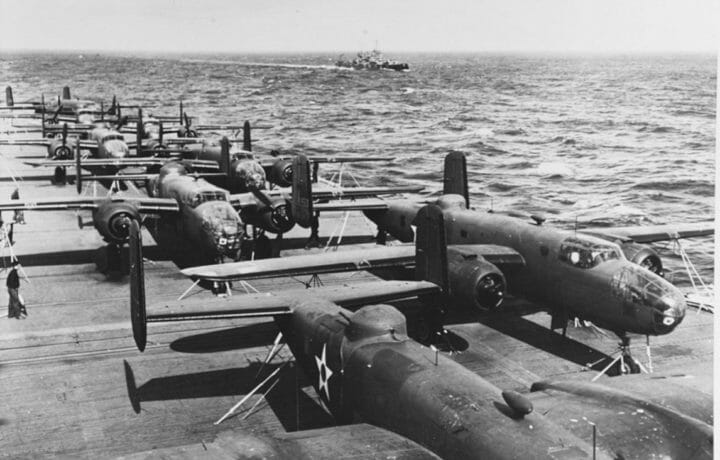“Those who cannot remember the past are condemned to repeat it.”
Seventy-seven years ago today, April 18, 1942, America struck back at Imperial Japan. Lieutenant Colonel Jimmy Doolittle led sixteen B-25 Mitchell twin-engine bombers in a raid on Tokyo, a daring and innovative effort that both surprised and stunned the Imperial Japanese. Sadly, the last surviving Raider, Robert Cole, recently passed away at 103 years old. This group of Americans deserves to be remembered for their bravery and sacrifice.
After the Imperial Japanese sneak attack on Pearl Harbor, the president sought a way to strike back. What became the Doolittle Raid was the brainchild of Captain Francis S. Low, USN, an operations officer working for the Chief of Naval Operations Admiral Ernest J. King. After seeing the new aircraft carrier USS Hornet and an airfield runway painted like a carrier deck, Low had a moment of insight – use Army Air Forces twin-engine bombers to attack Japan. On January 10, 1942, he secured King’s approval to explore the idea, and Low then approached the skipper of the aircraft carrier Hornet Captain Donald B. “Wu” Duncan. After some secret preliminary work, Low and Duncan discussed their idea with the Army Air Forces Lieutenant General Henry H. “Hap” Arnold, who then called Jimmy Doolittle.
“Jim, what airplane do we have that will take off in less than five hundred feet, with a two thousand pound bomb load, and fly two thousand miles?” Arnold asked. Doolittle determined that the B-25 could perform the mission, but it would be a one-way trip as the B-25 could take off from a moving carrier, but not land on one. Adding to the challenge, the B-25 had not yet seen combat.
After much preparation by Duncan and Doolittle, which included modifying the B-25s, the Hornet sailed from San Francisco Bay on April 1, 1942 with the B-25s parked on the deck. After linking up with Vice Admiral William F. Halsey’s Task Force 16, which included the aircraft carrier USS Enterprise to protect the Hornet, they steamed towards Japan. Japanese patrol boats, unfortunately, detected the task force, which forced them to launch the B-25s during daylight and 170 nautical miles farther from Japan than planned. Continuing to demonstrate his exemplary leadership, Doolittle himself flew the first plane off the Hornet. After the B-25s dropped their bombs on Tokyo, the raiders continued west to land in China, but due to their early launch from the Hornet, most of the raiders crash-landed or ditched in the sea, although the Soviets interned one crew that landed in the USSR. Most of the aircrew eventually made it to safety, but the Imperial Japanese captured, mistreated, and executed some.
Although the damage of the raid was negligible, the strategic results of the Tokyo Raid were significant. For the Americans, the strike was a tremendous boost to American morale after Pearl Harbor and a string of American defeats. Doolittle became a national hero, jumping from Lieutenant Colonel directly to Brigadier General and earning the Congressional Medal of Honor.
Doolittle initially regarded the effort as a failure. In Japan, however, the threat to the emperor caused a real reaction, as the Imperial Japanese military leaders were embarrassed in their inability to protect the emperor and the Home Islands. The result was to accept and even speed up the timetable for the Japanese attack on Midway Island. Due to the dispersion of their forces at the time, the Japanese had to use many coded messages to coordinate the attack and had to continue to use old codebooks, both of which helped American code breaking efforts and ultimately enabled the U.S. Navy to hand the Imperial Japanese Navy a crushing defeat in the Battle of Midway.
The Doolittle Raid was an example of an insight made practical through determined leadership and service cooperation that led to surprising the enemy and achieving strategic effect.


